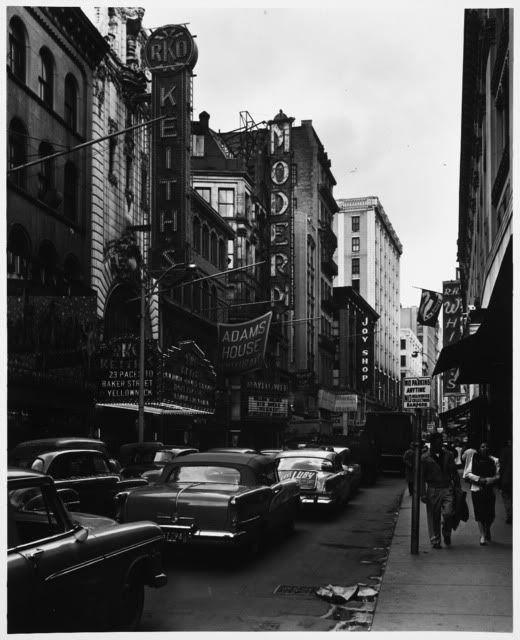The marquee is lit, the stage set, and the final piece of lower Washington Street?s revived theater district in place. Today the long-dormant Modern Theatre springs back to life.
It is a small performance space, a 185-seat jewel box with a backstage area that even its founding director, Marilyn Plotkins, describes as a ?postage stamp.?? But the reopening of the Modern, to be marked with a ribbon cutting today by owner Suffolk University ? which undertook the $41 million project to rebuild it ? is an important step forward for this section of the historic Theatre District.
The Modern joins the Paramount Center and the Boston Opera House, all in the row on Washington Street, to represent the reclaiming of a once-glorious cultural center that became a porn-soaked symbol of city decay.
Plotkins, the chairwoman of Suffolk?s theater department, said she?s planning a program that includes film, performances, and talks. She said the Modern won?t try to compete with the much larger Paramount or Opera House. Instead, its programming will be modeled after what one might find at the 92nd Street Y in New York City, she said.
?The idea is that you could do intimate performances that really focus on words and language,?? said Plotkins. ?We provide the intimate experience that can only be had in a small theater. Rather than saying, ?Why aren?t we 600 seats,? let?s celebrate the fact that we are one of three theaters on lower Washington Street built to do different things well.??
The Spanish dance ensemble Casa Patas will perform Nov. 30 with jazz trumpeter Arturo Sandoval. The Modern will host a Russian film festival, present the Actors? Shakespeare Project, and feature speaking engagements by comedian Lewis Black and novelist Maxine Hong Kingston.
There?s a rich history of entertainment in this block, which sits between Downtown Crossing and Boylston Street. At one point, the area was stuffed with theaters, from the nearly 1,800-seat movie palace known as the Paramount to the Opera House, opened in 1909. The Modern opened as a movie house in 1913 in a former retail and warehouse building. It is famous for being the first theater in Boston to have a sound projection machine.
By the 1960s, though, the theaters in the district had either closed or fallen into disrepair as the area became known as the Combat Zone, a place full of adult bookstores, pornographic movie houses, and strip clubs. There were still occasional performances in the Modern. Reviewing a 1979 production of David Mamet?s ?American Buffalo,?? Kevin Kelly wrote in The Boston Globe of the theater?s ?rancid, old closed-up closet odor.?? It closed for good in 1981.
?I?m old enough to remember there used to be the Astor Theater down there, a real movie house,?? said Mayor Thomas M. Menino, who pushed hard for the revival of the district. ?But in 1995, when we started this, there was no energy in that lower part of Washington Street. It?s a community that was closed after 5 o?clock. Now, it?s buzzing all night.Menino focused attention on the area, getting the Paramount, Opera House, and Modern on the National Trust for Historic Preservation?s 11 Most Endangered Historic Places list in 1995.
Eventually, Clear Channel Entertainment spent $38 million to renovate the Opera House and reopened it in 2004 with the touring production of ?The Lion King,?? and today it serves as the home stage of Boston Ballet. Emerson College then renovated the Paramount Center, which reopened in March with a 596-seat theater, scene shops, dance studios, and dorm rooms. Suffolk took on the Modern project to create a stage and dorm space.
Indeed, the Modern is more than a theater. Behind its restored facade sits a new 12-story building with dorm rooms for Suffolk students.
It was a challenging project. Though the city had required that the historic facade be preserved, the building itself was too damaged to save. Suffolk removed the stone and stored it in a nearby warehouse while the building was torn down so a new 10-story structure could be built on the site. The university, which paid for the project through bonds, spent $1.5 million alone on the building?s facade, a blend of white, Vermont marble with sandstone on its upper portion.
?There was no way of saving this facade unless somebody stepped up,?? said Richard Bertman of CBT Architects, the Boston firm that designed the project. ?This is more than any commercial developer would do.??
With the original theater space beyond repair, Suffolk commissioned artist John Lee Beatty to create a mural to cover the walls inside the house based on the patterns and colors of the Modern?s curtain. A long, narrow section of that original curtain has been preserved and displayed under plexiglass directly across from the entrance doors.
The theater itself includes an orchestra pit capable of fitting about 20 musicians and a section of seats that can be removed to increase the size of the stage.
All in all, Plotkins says, the Modern is a gem.
?In a 1914 article we read, the author wrote that we are the most elegent theater in Boston of its size,?? she said. ?We still are.??
Geoff Edgers can be reached at
gedgers@globe.com.[/email].



